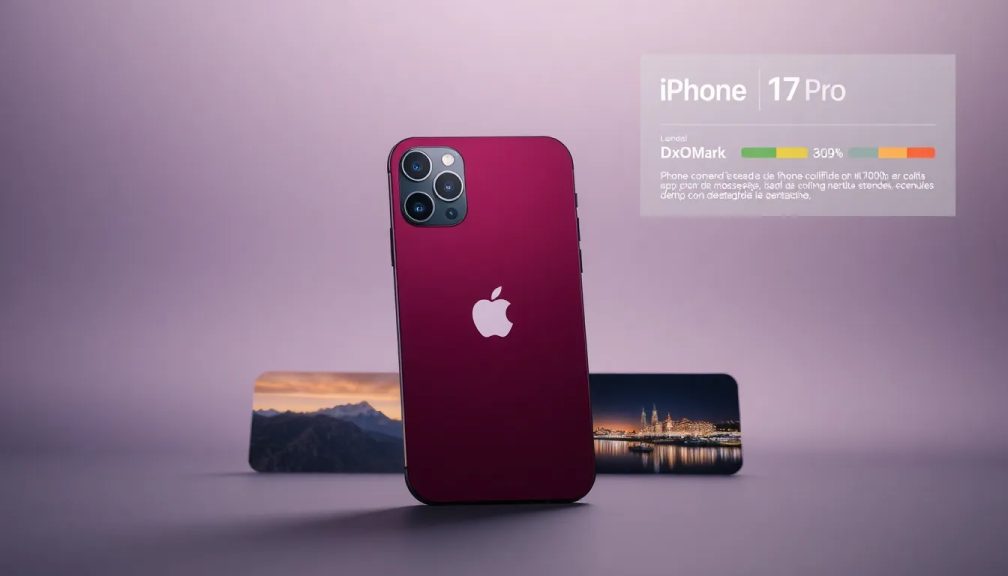iPhone 17 Pro ranks in top 3 for camera quality on DxOMark

In the ever-evolving landscape of smartphone technology, the competition to dominate the camera market is fierce. With the release of the iPhone 17 Pro and Pro Max, Apple has made significant strides in photography, but how does it stack up against its competitors? Let’s dive into the latest insights from DxOMark regarding the camera capabilities of these devices and explore where they excel and where they fall short.
- The iPhone 17 Pro Max: A Leader in Apple's Lineup, But Not in the Market
- Strengths and Weaknesses of the iPhone 17 Pro’s Camera Features
- The Competitive Landscape: Top Camera Phones Compared
- DxOMark Rankings and Their Impact on Consumer Choices
- Looking Ahead: Future Developments in Smartphone Photography
The iPhone 17 Pro Max: A Leader in Apple's Lineup, But Not in the Market
The iPhone 17 Pro Max has made a notable entry into the photography rankings, securing the third spot in the prestigious camera performance list. While this achievement is commendable, it's important to note that its reign at this level may be short-lived. The impending release of competitors, including the Xiaomi 17 Pro Max and the upcoming Samsung Galaxy S26, signals that the iPhone will have to give up its place soon.
Despite being one of the most expensive smartphones available, the iPhone 17 Pro does not consistently dominate the market in camera performance. However, it has made notable improvements compared to previous models. Its strengths lie particularly in video quality, making it an excellent choice for videographers.
This latest model shares its camera setup with its sibling, the Pro Max, and has seen significant enhancements in zoom capabilities and low-light performance. The 48-megapixel sensors across all lenses contribute to better detail, especially in challenging lighting conditions.
Strengths and Weaknesses of the iPhone 17 Pro’s Camera Features
The iPhone 17 Pro is recognized for its strengths in various photography aspects, particularly in video performance. Here are some highlights:
- Video Quality: Exceptional balance of whites and minimal noise.
- Outdoor Photography: Accurate exposure and a wide dynamic range.
- Color Accuracy: Pleasant color palette and generally neutral white balance.
- Zoom Capabilities: Significant improvement due to the 48 MP telephoto sensor.
- Low-Light Performance: Enhanced capabilities for nighttime photography.
However, there are some areas for improvement:
- Moving Subjects: Slight instability in focus and white balance during video recording.
- Intermediate Zoom: Loss of texture when using mid-range zoom settings.
- Indoor Conditions: Some noise can be evident in low-light scenarios.
- Strong Sunlight: Tendency for a yellowish tint in bright conditions; darker skin tones may appear reddish.
The Competitive Landscape: Top Camera Phones Compared
While the iPhone 17 Pro Max shines in many areas, it faces stiff competition from several rivals. Notably, the Oppo Find X8 Ultra, launched in April of this year, has taken the lead in many rankings. Additionally, the Huawei Pura 80 Ultra, released in June, continues to hold the top spot.
Recent additions to the market, such as the Huawei Pura 70 Ultra and the Google Pixel 10 Pro XL, also showcase impressive photographic capabilities, demonstrating that the Chinese market is currently at the forefront of camera technology. Here’s a quick overview of the current top contenders:
| Rank | Smartphone Model | Camera Features |
|---|---|---|
| 1 | Huawei Pura 80 Ultra | Exceptional low-light performance and detail |
| 2 | Oppo Find X8 Ultra | Advanced zoom capabilities and color accuracy |
| 3 | Apple iPhone 17 Pro Max | Best video quality and overall performance |
| 4 | Google Pixel 10 Pro XL | Strong image processing and dynamic shots |
| 5 | Huawei Pura 70 Ultra | Good balance in various lighting conditions |
DxOMark Rankings and Their Impact on Consumer Choices
DxOMark is a renowned authority in camera performance testing, providing insights that influence consumer choices significantly. Their evaluations consider multiple factors, including image quality, video performance, and usability in different environments.
As technology continues to advance, consumers are becoming increasingly discerning about camera capabilities in smartphones. The rankings serve as a guide for potential buyers, helping them make informed decisions based on their photography needs.
For those interested in a comprehensive analysis, you might consider watching this insightful video that explores the camera features of the iPhone 17 Pro:
Looking Ahead: Future Developments in Smartphone Photography
The smartphone market is dynamic, and with each iteration, manufacturers are pushing the boundaries of what is possible in mobile photography. Upcoming models, such as Samsung's Galaxy S26 and Xiaomi's flagship offerings, are expected to continue this trend, introducing innovative camera technologies and features.
As we move into 2026, it's clear that the competition will be fierce, and brands will need to stay ahead of consumer expectations. Features like AI-driven photography enhancements, improved low-light capabilities, and advanced image stabilization are expected to be at the forefront of new releases.
Ultimately, for those prioritizing photography in their smartphone choices, keeping an eye on the latest developments and benchmarks will be crucial for making the best decision.




Leave a Reply